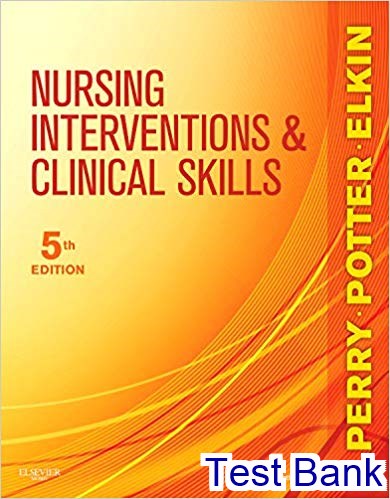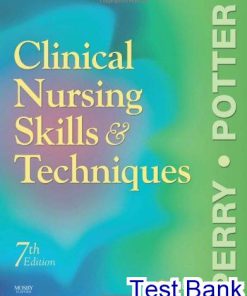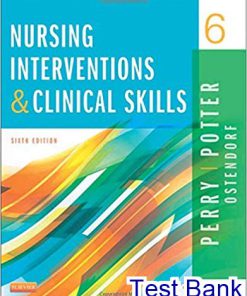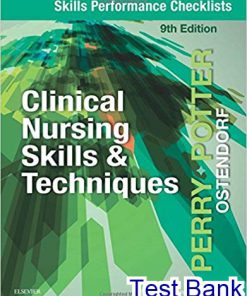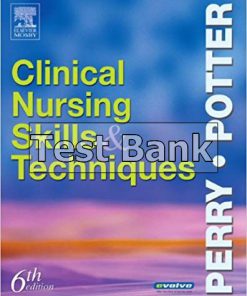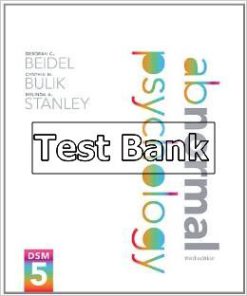Unit 1: Quality and Safety in Nursing Practice
Chapter 1: Using Evidence in Nursing Practice NEW!
Chapter 2: Communication & Collaboration
- Skill 2.1 Establishing the Nurse-Client Relationship
- Skill 2.2 Interviewing
- Skill 2.3 Communications with Anxious, Angry, Depressed Patients, and Cognitively Impaired Patients
- Skill 2.4 Interprofessional Conflict Resolution NEW!
- Procedural Guideline 2.1 Hand-Off Communications NEW!
- Procedural Guideline 2.2 S-BAR Communication NEW!
Chapter 3: Documentation and Informatics
- Procedure Guideline 3.1 Documenting Nurses’ Progress Notes
- Procedural Guideline 3.2 Using an Electronic Medical Record NEW!
- Procedural Guideline 3.3 Writing an Occurrence Report
Chapter 4: Patient Safety & Quality Improvement
- Procedural Guideline 4.1 Medical Error Reduction NEW!
- Skill 4.1 Fall Prevention
- Skill 4.2 Designing a Restraint Free Environment
- Skill 4.3 Applying Physical Restraints
- Skill 4.4 Seizure Precautions
- Skill 4.5 Fire, Electrical, and Radiation Safety
- Procedural Guideline 4.2 Conducting a Root Cause Analysis NEW!
Chapter 5: Infection Control
- Procedural Guideline 5.1 Medical Asepsis Principles NEW!
- Procedural Guideline 5.2 Surgical Asepsis Principles NEW!
- Skill 5.1 Hand Hygiene
- Skill 5.2 Applying Personal Protective Equipment
- Skill 5.3 Caring for Patients under Isolation Precautions
- Procedural Guideline 5.3 Special Tuberculosis Precautions
- Skill 5.4 Preparing & Maintaining a Sterile Field
- Skill 5.6 Applying Sterile Gloves
Unit 2: Patient Assessment Skills
Chapter 6: Vital Signs
- Skill 6.1 Measuring Body Temperature
- Skill 6.2 Assessing Pulse: Apical
- Skill 6.3 Assessing Pulse: Radial
- Procedural Guideline 6.1 Assessing Pulse: Apical Radial
- Skill 6.4 Assessing Respirations
- Skill 6.5 Assessing Blood Pressure
- Procedural Guideline 6.2 Assessing Blood Pressure Electronically
Chapter 7: Health Assessment
- Skill 7.1 General Survey
- Procedural Guideline 7.1 Monitoring Intake and Output
- Skill 7.2 Assessing the Head and Neck
- Skill 7.3 Assessing the Thorax and Lungs
- Skill 7.4 Cardiovascular Assessment
- Skill 7.5 Assessing the Abdomen
- Skill 7.6 Assessing the Genitalia and Rectum NEW!
- Skill 7.7 Musculoskeletal and Neurological Assessment
Chapter 8: Specimen Collection
- Skill 8.1 Urine Specimen Collection
- Procedural Guideline 8.1 Collecting a Timed Urine Specimen
- Procedural Guideline 8.2 Urine Testing
- Skill 8.2 Testing for Gastrointestinal Alterations—Gastroccult Test, Stool Specimen, and Hemoccult Test
- Skill 8.3 Collecting Specimens from the Nose and Throat
- Skill 8.4 Collecting a Sputum Specimens
- Skill 8.5 Obtaining Wound Drainage Specimens
- Skill 8.6 Blood Glucose Monitoring
- Skill 8.7 Performing Venipuncture
Chapter 9: Diagnostic Procedures
- Skill 9.1 Contrast Media Studies
- Skill 9.2 Care of Patients Undergoing Aspirations—Bone Marrow, Lumbar Puncture, Paracentesis, and Thoracentesis
- Skill 9.3 Care of Patients Undergoing Bronchoscopy
- Skill 9.4 Care of Patients Undergoing Gastrointestinal Endoscopy
- Skill 9.5 Obtaining an Electrocardiogram
Unit 3: Basic Human Needs
Chapter 10: Bathing and Personal Hygiene
- Skill 10.1 Complete Bathing
- Procedural Guideline 10.1 Perineal Care
- Procedural Guideline 10.2 Use of the Disposable Bag Bath
- Procedural Guideline 10.3 Oral Care for Debilitated Patient
- Procedural Guideline 10.4 Care of Dentures
- Procedural Guideline 10.5 Hair Care—Combing, Shampooing, Shaving
- Procedural Guideline 10.6 Nail & Foot Care
- Procedural Guideline 10.6 Bed Making —Unoccupied
- Procedural Guideline 10.7 Bed Making—Occupied
Chapter 11: Care of the Eye and Ear
- Skill 11.1 Eye Irrigation
- Procedural Guideline 11.1 Eye Care for the Comatose Patient NEW!
- Procedural Guideline 11.2 Caring for an Artificial Eye
- Skill 11.2 Ear Irrigation
- Skill 11. 3 Caring for a Hearing Aid
Chapter 12: Promoting Nutrition
- Skill 12.1 Feeding Dependent Patients
- Skill 12.2 Aspiration Precautions
- Skill 12.3 Insertion and Removal of a Small-Bore Feeding Tube
- Skill 12.4 Verifying Placement & Irrigating a Feeding Tube
- Skill 12.5 Administering Tube Feedings for Nasogastric, Gastrostomy, and Jejunostomy Tubes
- Procedural Guideline 12.1 Site Care of Enteral Feeding Tubes NEW!
Chapter 13: Pain Management
- Skill 13.1 Nonpharmacological Pain Management
- Procedural Guideline 13.1 Relaxation and Guided Imagery
- Skill 13.2 Pharmacologic Pain Management
- Skill 13.3 Patient-Controlled Analgesia
- Skill 13.4 Epidural Analgesia
- Skill 13.5 Local Anesthetics Infusion Pump for Analgesia
Chapter 14: Promoting Oxygenation
- Skill 14.1 Oxygen Administration
- Skill 14.2 Airway Management: Noninvasive Interventions
- Procedural Guideline 14.1 Use of a Peak Flow-Meter
- Skill 14.3 Chest Physiotherapy
- Skill 14.4 Airway Management: Suctioning
- Skill 14.5 Airway Management: Endotracheal Tube and Tracheostomy Care
- Skill 14.6 Managing Closed Chest Drainage Systems
Unit 4: Activity and Mobility
Chapter 15: Safe Patient Handling
- Skill 15.1 Using Safe and Effective Transfer Techniques
- Skill 15.2 Moving & Positioning Patients in Bed
- Skill 15.3 Assisting in the Use of a Wheelchair
Chapter 16: Exercise & Mobility
- Procedural Guideline 16.1 Range of Motion
- Skill 16.1 Continuous Passive Motion
- Procedural Guideline 7.2 Applying Elastic Stockings and Sequential Compression Device
- Skill 16.2 Assisting with Ambulation
- Skill 16.3 Teaching Use of Canes, Crutches, Walkers
Chapter 17: Support Surfaces and Special Beds
- Skill 17.1 Selection of Pressure-Reducing Surfaces NEW!
- Skill 17.2 Placing a Patient on a Support Surface
- Skill 17.3 Placing a Patient on an Air-Suspension Bed
- Skill 17.4 Placing a Patient on an Air-Fluidized Bed
- Skill 17.5 Placing a Patient on a Bariatric Bed
- Skill 17.6 Placing a Patient on a Rotokinetic Bed
Chapter 18: Traction, Cast Care, and Immobilization Devices
- Skill 18.1 Care of the Client in Skin Traction
- Skill 18.2 Care of the Client in Skeletal Traction and Pin Site Care
- Skill 18.3 Care of the Client During Cast Application
- Procedural Guideline 18.1 Care of the Client During Cast Removal
- Skill 18.4 Care of the Client with an Immobilization Device—Brace, Splint, or Sling
Unit 5: Promoting Elimination
Chapter 19: Urinary Elimination
- Procedural Guideline 19.1 Assisting with Use of a Urinal
- Skill 19.1 Applying a Condom Catheter
- Procedural Guideline 19.2 Bladder Scan (cross reference to Skill 19.2)
- Skill 19.2 Insertion of a Straight or Indwelling Catheter (cross reference to PG 19.2)
- Skill 19.3 Removal of Indwelling Catheter
- Procedural Guideline 19.3 Care of Indwelling Catheter
- Skill 19.4 Suprapubic Catheterization
- Skill 19.5 Performing Catheter Irrigation
- Procedural Guideline 19.4 Continuous Ambulatory Peritoneal Dialysis
Chapter 20: Bowel Elimination
- Procedural Guideline 20.1 Providing a Bedpan
- Skill 20.1 Removing Fecal Impaction
- Skill 20.2 Administering an Enema
- Skill 20.3 Insertion, Maintenance, and Removal of a Nasogastric Tube for Decompression
Chapter 21: Ostomy Care
- Skill 21.1 Pouching a Bowel Diversion
- Skill 21.2 Pouching an Incontinent Urostomy
- Skill 21.3 Catheterizing a Urinary Diversion NEW!
Unit 6: Medication Administration
Chapter 22: Preparation for Safe Medication Administration
Chapter 23: Nonparenteral Medications
- Skill 23.1 Administering Oral Medications
- Skill 23.2 Administering Medications Through a Feeding Tube
- Skill 23.3 Applying Topical Medications to the Skin
- Procedural Guideline 23.1 Administering Nasal Medications NEW!
- Skill 23.4 Administering Eye Medications
- Skill 23.5 Administering Ear Medications
- Skill 23.6 Using Metered-Dose Inhalers (MDI)
- Procedural Guideline 23.2 Using Dry Powder Inhaled Medications
- Skill 23.7 Using Small-Volume Nebulizers
- Procedural Guideline 23.3 Administering Rectal Medications
- Procedural Guideline 23.4 Administering Vaginal Medications
Chapter 24: Parenteral Medications
- Skill 24.1 Preparing Injections—Vial, Ampule, Dry Powder and Cartridge
- Procedural Guideline 24.1 Mixing Medications from Vials
- Skill 24.2 Subcutaneous Injections
- Skill 24.3 Intramuscular Injections
- Skill 24.4 Intradermal Injections
- Skill 24.5 Adding Medications to IV Fluid Containers
- Skill 24.6 Administering Intravenous Piggyback, Intermittent Infusion Sets, and Mini-IV Pump
- Skill 24.7 Administering Medications Intravenous Bolus
- Skill 24.8 Continuous Subcutaneous Infusion
Unit 7: Dressings and Wound Care
Chapter 25: Wound Care and Irrigation
- Procedural Guideline 25.1 Performing a Wound Assessment NEW!
- Skill 25.1 Performing Irrigation NEW!
- Skill 25.2 Managing Drainage Evacuation
- Skill 25.3 Removing Sutures and Staples
- Skill 25.4 Negative Pressure Wound Therapy
Chapter 26: Pressure Ulcers
- Skill 26.1 Pressure Ulcer Risk Assessment and Prevention Strategies
- Skill 26.2 Treatment of Pressure Ulcers and Wound Management
Chapter 27: Dressings Bandages and Binders
- Skill 27.1 Applying a Dressing (Dry and Moist-to-Dry)
- Skill 27.2 Applying a Pressure Bandage
- Procedural Guideline 27.1 Applying a Transparent Dressing
- Skill 27.3 Applying a Hydrocolloid, Hydrogel, Foam, or Absorption Dressing
- Procedural Guideline 27.2 Applying Gauze and Elastic Bandages
- Procedural Guideline 27.3 Applying an Abdominal and Breast Binder
Chapter 28: Therapeutic Use of Heat and Cold
- Skill 28.1 Moist Heat
- Skill 28.2 Dry Heat
- Skill 28.3 Cold Applications
Unit 8: Complex Nursing Interventions
Chapter 29: Intravenous Therapy
- Skill 29.1 Insertion of a Peripheral Intravenous Device
- Skill 29.2 Regulating Infusion Flow Rate
- Skill 29.3 Maintenance of Intravenous Site
- Procedural Guideline 29.1 Discontinuing Peripheral Intravenous Access
- Skill 29.4 Care of Patients with Central Venous Access Devices
- Skill 29.5 Administration of Parenteral Nutrition
- Skill 29.6 Transfusions of Blood Products
Chapter 30: Pre-Operative and Post-Operative Care
- Skill 30.1 Preoperative Assessment
- Skill 30.2 Preoperative Teaching
- Skill 30.3 Physical Preparation for Surgery
- Skill 30.4 Managing the Patient Receiving Moderate Sedation
- Skill 30.5 Providing Immediate Anesthesia Recovery in the Postanesthesia Care Unit
- Skill 30.6 Providing Early Postoperative and Convalescent Phase Recovery
Chapter 31 Emergency Measures for Life Support in the Hospital Setting
- Skill 31.1 Inserting an Oropharyngeal Airway
- Skill 31.2 Using an AED
- Skill 31.3 Code Management
Unit 9: Supportive Nursing Interventions
Chapter 32: Palliative Care
- Skill 32.1 Supporting Patients and Families in Grief
- Skill 32.2 Care of the Dying Client
- Skill 32.3 Care of the Body after Death
Chapter 33: Home Care Safety
- Skill 33.1 Home Health Safety and Assessment
- Skill 33.2 Adapting the Home Setting for Clients with Cognitive Deficits
- Skill 33.3 Medication and Medical Device Safety
Appendices
A: Answer key to end-of-chapter exercises
B: Abbreviations and Equivalents
